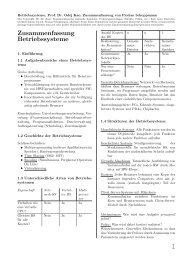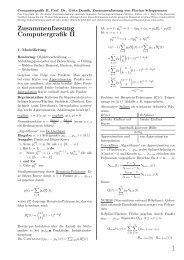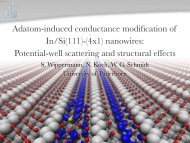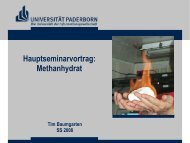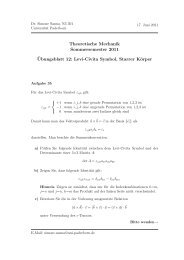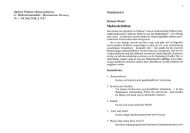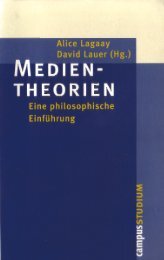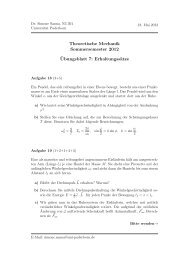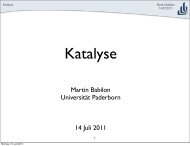Skript / lecture notes - Universität Paderborn
Skript / lecture notes - Universität Paderborn
Skript / lecture notes - Universität Paderborn
Erfolgreiche ePaper selbst erstellen
Machen Sie aus Ihren PDF Publikationen ein blätterbares Flipbook mit unserer einzigartigen Google optimierten e-Paper Software.
Prof. Dr. Wolf Gero Schmidt<br />
<strong>Universität</strong> <strong>Paderborn</strong>, Lehrstuhl für Theoretische Physik<br />
• reduziert um die Selbstwechselwirkung reduced by the self-interaction<br />
∫ e 2 |ϕ j (¯r ′ )| 2<br />
d 3¯r ′ = V<br />
|¯r − ¯r ′ SI (r)<br />
|<br />
Wie kann man die Hartree-Gleichung lösen, wenn das effektive Potential<br />
V eff (¯r) = V (¯r) + V H (¯r) − V SI (¯r)<br />
von der (zunächst unbekannten) Teilchendichte n(¯r) abhängt?<br />
⇒ ”Selbstkonsistenzverfahren”<br />
The difficulty with solving this problem is that the Hartree potential connects the<br />
solutions of each of the single-particle states. In other words, this potential for particle<br />
m depends on the states of all the other N − 1 particles. For this reason, it is sometimes<br />
referred to as the ”Self-Consistent” potential. The difficulty in solving for the N−particle<br />
state is simply that of finding a set of single particle states ϕ i that together are solutions<br />
to the Hartree equation.<br />
Starten von geratener Startladungsdichte e 2 n 0 (¯r) (z.B. aus der Superposition atomarer<br />
Ladungsdichten) und iterieren die Hartree-Gleichung, bis sich die WF (und damit das<br />
Potential) nicht mehr ändern.<br />
Blockdiagramm des selbstkonsistenten Verfahrens zur Lösung der Hartree-Gleichung:<br />
62




